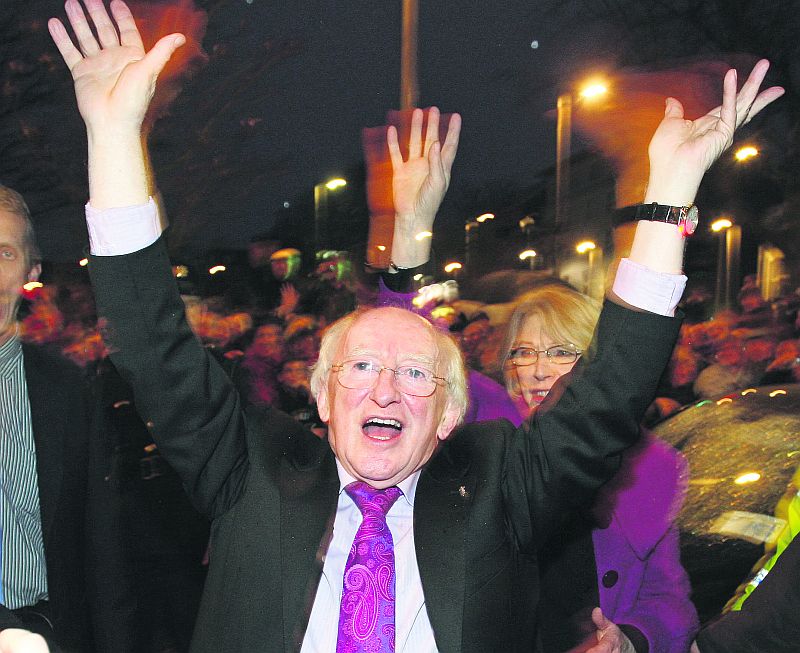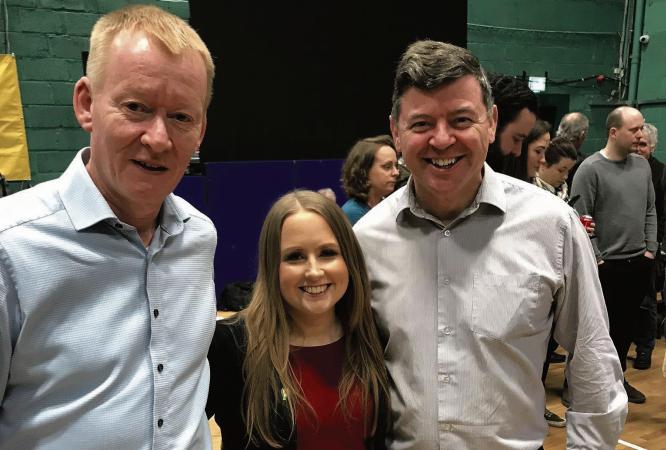Political World
Presidential Referendum really just a red herring

World of Politics with Harry McGee – harrymcgee@gmail.com
It is almost certain that three referendums that have been proposed by this Government during its term of office will have been rejected by the people.
They were the proposal to give parliamentary inquiries more power; the plan to abolish the Seanad; and the silly referendum on reducing the eligible age of a Presidential candidate from 35 to 21 (with everything else going on in the world, they could surely have thought of something less, well, trivial).
The question is – will the people reject a fourth referendum, namely the referendum on same-sex marriage this weekend.
At this stage the evidence and data suggests not. The gap looks a little too wide. That said, there have been dramatic swings in the last week of a lot of election and referendum campaigns that opinion polls have not picked up. In addition to that, opinion polls get things wrong.
A really good example of a late intervention was when five or six former Attorneys General wrote a letter expressing their concern at the powers that parliamentarians would have if the inquiries referendum were to pass.
The stock of politicians was on the floor at the time. The public took note of the concerns and were damned if they were going to give any more powers to those untrustworthy TDs and Senators.
The rule of thumb is that a closer to polling day an opinion poll is taken, the more accurate it is. For example, last December, 80 per cent of people polled said they supported same-sex marriage.
That figure had to be taken with a large grain of salt. For one, a lot of those asked had not really thought about it and gave an answer that was almost arbitrary, or answered what they thought might be the ‘right’ answer without even thinking about it.
Closer to polling day, when they have thought about it, their voting intention might very well change. So the polls are usually not too far wrong.
But often they fail to pick up late swings. Opinion polls also fail to pick up what are known as ‘shy voters’ – those who vote for an issue or for a party but won’t admit it publicly.
In addition to that, far more people tell pollsters they will vote than actually do. The road to hell is paved with good intentions. Many of those who say they will vote don’t turn up, especially for second-tier elections.
One of the fears of Yes campaigners in the same-sex referendum is that the young won’t vote – especially the youngest 18-24 age group.
That group is the strongest supporter of a Yes vote (with 71 per cent in favour). Yet it is also the group that votes in the lowest percentage.
By contrast, the age group that is most strongly opposed to change is the over 65 age group, where only 34 per cent is in favour. Unlike their young counterparts, this group tends to vote in large numbers.
For more, read this week’s Connacht Tribune.
Connacht Tribune
The fine art of good timing when it comes to elections

World of Politics with Harry McGee
Academically, politics is described as a science. But in the real world, it’s more of an art – and one of the big decisions a Government has to make is to decide when to call an election.
Will they see out the full term, or will they go early – either to mitigate the damage they will ship, or to secure a victory before things go awry, or the economy takes a dip, or some kind of controversy erupts?
Timing is everything.
And there’s a bit of art to that – not to mention a lot of luck. If you call it early and win big, you’re a genius. If you call it early and lose, you are the political version of the village fool.
Charlie Haughey was a poor judge of the public mood. Twice he called snap elections and on both occasions they backfired. Haughey succeeded Jack Lynch as Taoiseach in late 1979 and did not – technically – have his own mandate. He tried to remedy that by calling an election in 1981. But it recoiled. Ray MacSharry warned him not to hold it during the H Block hunger strikes when republican prisoners were dying each day. He did not listen to the advice and found himself out of office.
After his return to power in 1987, Haughey tired of presiding over a minority government that kept on losing votes in the Oireachtas (the opposition won nine private members motions).
So he called a snap general election and it backfired. Fianna Fáil lost seats and had to broker a coalition deal with the Progressive Democrats and his long-standing political adversary Dessie O’Malley.
For more, read this week’s Connacht Tribune.
Connacht Tribune Digital Edition App
Download the Connacht Tribune Digital Edition App to access to Galway’s best-selling newspaper.
Click HERE to download it for iPhone and iPad from Apple’s App Store, or HERE to get the Android Version from Google Play.
Or purchase the Digital Edition for PC, Mac or Laptop from Pagesuite HERE.
Get the Connacht Tribune Live app
The Connacht Tribune Live app is the home of everything that is happening in Galway City and county. It’s completely FREE and features all the latest news, sport and information on what’s on in your area. Click HERE to download it for iPhone and iPad from Apple’s App Store, or HERE to get the Android Version from Google Play.
Connacht Tribune
Inch protest arguments are more subtle than Oughterard

World of Politics with Harry McGee
I was cycling down Mount Street in Dublin on Tuesday. It’s a wide esplanade that links the Grand Canal with Merrion Square. The street is a mixture of fine Georgian buildings and modern office blocks.
About half-way down is the office of the International Protection Office, which deals with asylum seekers who have arrived in the country.
Needless to say, the office has been overwhelmed in the past year. Besides an estimated 80,000 refugees who have arrived from Ukraine, there have been about 20,000 people from other parts of the world who have arrived into Dublin (mostly) claiming asylum.
The numbers peaked around Christmas, but they have been falling a little. In January, more than 1,300 people arrived seeking asylum but the numbers fell back to 831 and 858, in February and March respectively.
They are still huge numbers in a historical context.
So back to my cycle on Tuesday. I knew that some asylum seekers were camping outside the International Protection Office, but I was taken aback by how many. There were six tents lined up on the pavement directly outside. Then on the ramp that led down to the basement carpark on the side of the building, there were about another 20 tents.
It looked like what it was, a refugee camp in the middle of Dublin’s business district. If you pan out from Mount Street, you will find tents here and there in nearby streets and alleys. There were a good few tents in an alleyway off Sandwith Street about 500 metres away.
For more, read this week’s Connacht Tribune.
Connacht Tribune Digital Edition App
Download the Connacht Tribune Digital Edition App to access to Galway’s best-selling newspaper.
Click HERE to download it for iPhone and iPad from Apple’s App Store, or HERE to get the Android Version from Google Play.
Or purchase the Digital Edition for PC, Mac or Laptop from Pagesuite HERE.
Get the Connacht Tribune Live app
The Connacht Tribune Live app is the home of everything that is happening in Galway City and county. It’s completely FREE and features all the latest news, sport and information on what’s on in your area. Click HERE to download it for iPhone and iPad from Apple’s App Store, or HERE to get the Android Version from Google Play.
Connacht Tribune
Sinn Féin hunt for seats in ‘locals’ across Galway

World of Politics with Harry McGee
God that was a dramatic and historic weekend in England, wasn’t it? So much excitement, so much change, so much hype, so much out with the old and in with the new, and what looks like the coronation of a new leader. Yes, the local elections in Britain were something else weren’t they!
Apologies for not going on about King Charles III but the contract I signed when I became a lifelong republican forbids me to discuss the topic!
I know the British local elections sound a bit boring by comparison, but the results were stunning.
The Conservatives lost nearly 1,000 seats, the British Labour Party gained almost 500 and both the Lib Dems (with 350 gains) and the Greens (gaining over 200) also had amazing days at the polls.
It was Labour’s best day since 2002 but its victory was only partial. The Greens and the Lib Dems actually made gains at the expense of Labour in more affluent areas, and in parts of Britain where there were high numbers of graduates.
It was in the Red Wall constituencies in the North of England where the Labour recovery was strongest. These are working class constituencies with pockets of deprivation where people voted for the Labour Party forever. But all of those constituencies voted for Brexit and then voted for the Tories in the next general election. Labour is now winning back some of those votes.
Local elections are classified as second-tier elections which essentially means – from a national perspective – they are not life-or-death affairs, and not everything turns on them. Of course, it’s really important to have good local representation. But they are not an amazing weather vane for who rules the country.
For more, read this week’s Connacht Tribune.
Connacht Tribune Digital Edition App
Download the Connacht Tribune Digital Edition App to access to Galway’s best-selling newspaper.
Click HERE to download it for iPhone and iPad from Apple’s App Store, or HERE to get the Android Version from Google Play.
Or purchase the Digital Edition for PC, Mac or Laptop from Pagesuite HERE.
Get the Connacht Tribune Live app
The Connacht Tribune Live app is the home of everything that is happening in Galway City and county. It’s completely FREE and features all the latest news, sport and information on what’s on in your area. Click HERE to download it for iPhone and iPad from Apple’s App Store, or HERE to get the Android Version from Google Play.












